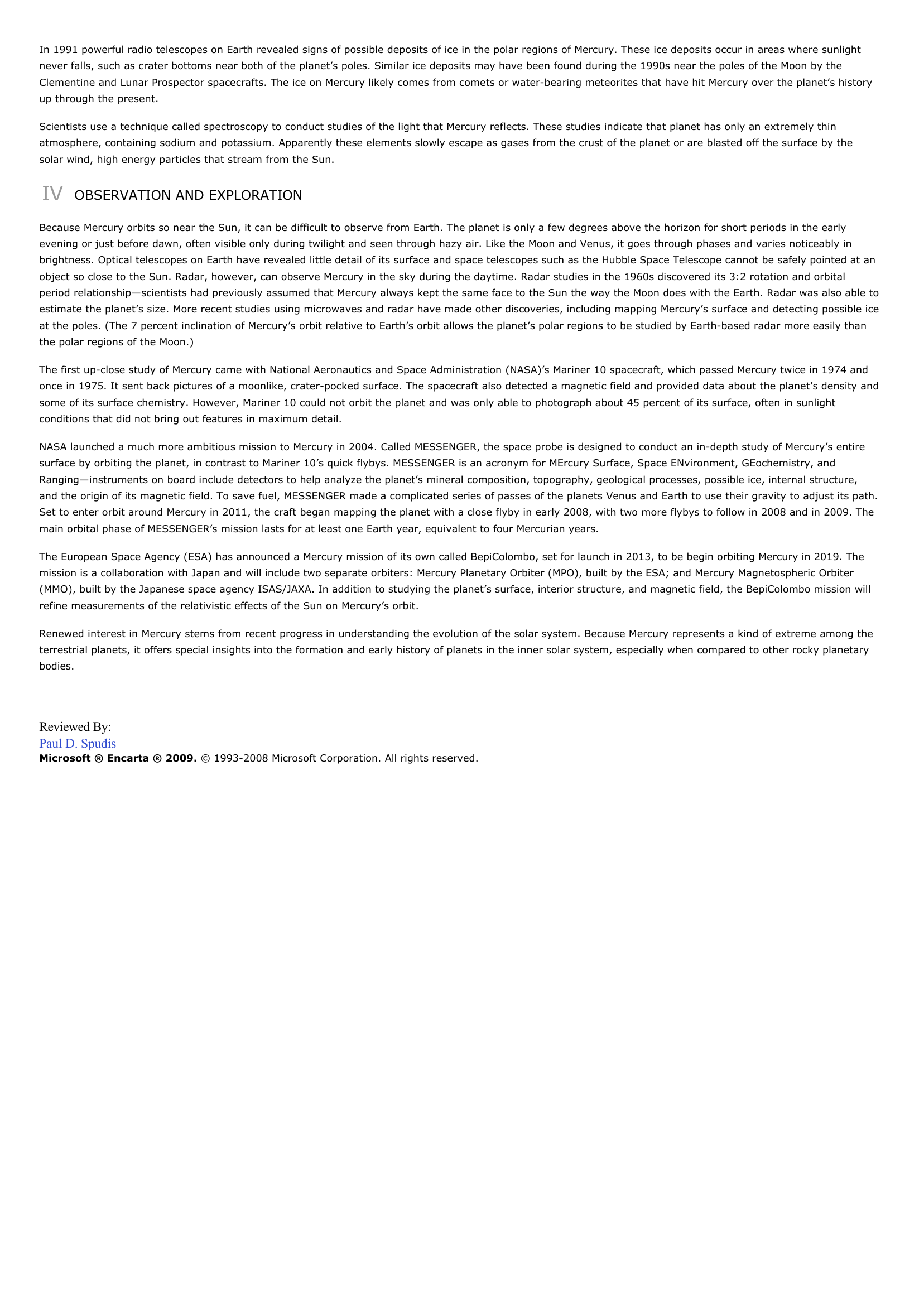Mercury (planet) - astronomy.
Publié le 11/05/2013

Extrait du document
«
In 1991 powerful radio telescopes on Earth revealed signs of possible deposits of ice in the polar regions of Mercury.
These ice deposits occur in areas where sunlightnever falls, such as crater bottoms near both of the planet’s poles.
Similar ice deposits may have been found during the 1990s near the poles of the Moon by theClementine and Lunar Prospector spacecrafts.
The ice on Mercury likely comes from comets or water-bearing meteorites that have hit Mercury over the planet’s historyup through the present.
Scientists use a technique called spectroscopy to conduct studies of the light that Mercury reflects.
These studies indicate that planet has only an extremely thinatmosphere, containing sodium and potassium.
Apparently these elements slowly escape as gases from the crust of the planet or are blasted off the surface by thesolar wind, high energy particles that stream from the Sun.
IV OBSERVATION AND EXPLORATION
Because Mercury orbits so near the Sun, it can be difficult to observe from Earth.
The planet is only a few degrees above the horizon for short periods in the earlyevening or just before dawn, often visible only during twilight and seen through hazy air.
Like the Moon and Venus, it goes through phases and varies noticeably inbrightness.
Optical telescopes on Earth have revealed little detail of its surface and space telescopes such as the Hubble Space Telescope cannot be safely pointed at anobject so close to the Sun.
Radar, however, can observe Mercury in the sky during the daytime.
Radar studies in the 1960s discovered its 3:2 rotation and orbitalperiod relationship—scientists had previously assumed that Mercury always kept the same face to the Sun the way the Moon does with the Earth.
Radar was also able toestimate the planet’s size.
More recent studies using microwaves and radar have made other discoveries, including mapping Mercury’s surface and detecting possible iceat the poles.
(The 7 percent inclination of Mercury’s orbit relative to Earth’s orbit allows the planet’s polar regions to be studied by Earth-based radar more easily thanthe polar regions of the Moon.)
The first up-close study of Mercury came with National Aeronautics and Space Administration (NASA)’s Mariner 10 spacecraft, which passed Mercury twice in 1974 andonce in 1975.
It sent back pictures of a moonlike, crater-pocked surface.
The spacecraft also detected a magnetic field and provided data about the planet’s density andsome of its surface chemistry.
However, Mariner 10 could not orbit the planet and was only able to photograph about 45 percent of its surface, often in sunlightconditions that did not bring out features in maximum detail.
NASA launched a much more ambitious mission to Mercury in 2004.
Called MESSENGER, the space probe is designed to conduct an in-depth study of Mercury’s entiresurface by orbiting the planet, in contrast to Mariner 10’s quick flybys.
MESSENGER is an acronym for MErcury Surface, Space ENvironment, GEochemistry, andRanging—instruments on board include detectors to help analyze the planet’s mineral composition, topography, geological processes, possible ice, internal structure,and the origin of its magnetic field.
To save fuel, MESSENGER made a complicated series of passes of the planets Venus and Earth to use their gravity to adjust its path.Set to enter orbit around Mercury in 2011, the craft began mapping the planet with a close flyby in early 2008, with two more flybys to follow in 2008 and in 2009.
Themain orbital phase of MESSENGER’s mission lasts for at least one Earth year, equivalent to four Mercurian years.
The European Space Agency (ESA) has announced a Mercury mission of its own called BepiColombo, set for launch in 2013, to be begin orbiting Mercury in 2019.
Themission is a collaboration with Japan and will include two separate orbiters: Mercury Planetary Orbiter (MPO), built by the ESA; and Mercury Magnetospheric Orbiter(MMO), built by the Japanese space agency ISAS/JAXA.
In addition to studying the planet’s surface, interior structure, and magnetic field, the BepiColombo mission willrefine measurements of the relativistic effects of the Sun on Mercury’s orbit.
Renewed interest in Mercury stems from recent progress in understanding the evolution of the solar system.
Because Mercury represents a kind of extreme among theterrestrial planets, it offers special insights into the formation and early history of planets in the inner solar system, especially when compared to other rocky planetarybodies.
Reviewed By:Paul D.
SpudisMicrosoft ® Encarta ® 2009. © 1993-2008 Microsoft Corporation.
All rights reserved..
»
↓↓↓ APERÇU DU DOCUMENT ↓↓↓
Liens utiles
- Earth (planet) - astronomy.
- Jupiter (planet) - astronomy.
- Mars (planet) - astronomy.
- Neptune (planet) - astronomy.
- Uranus (planet) - astronomy.


